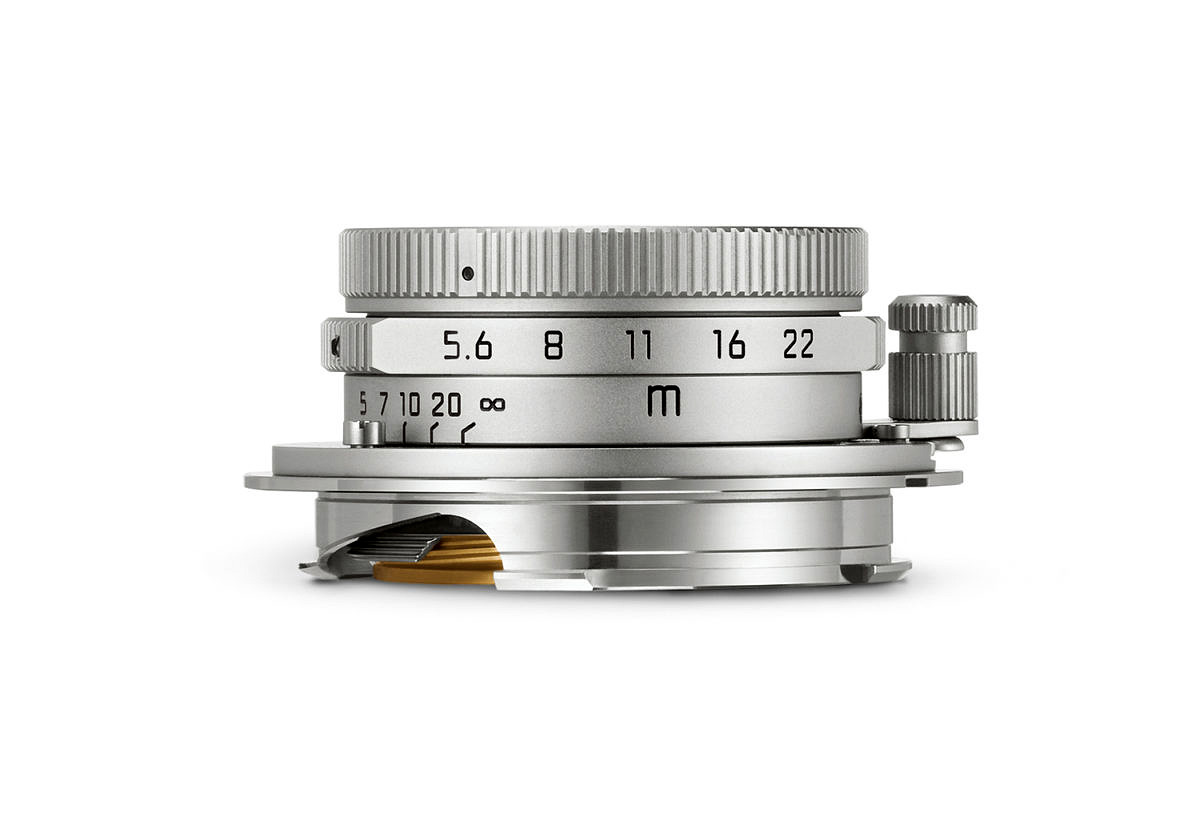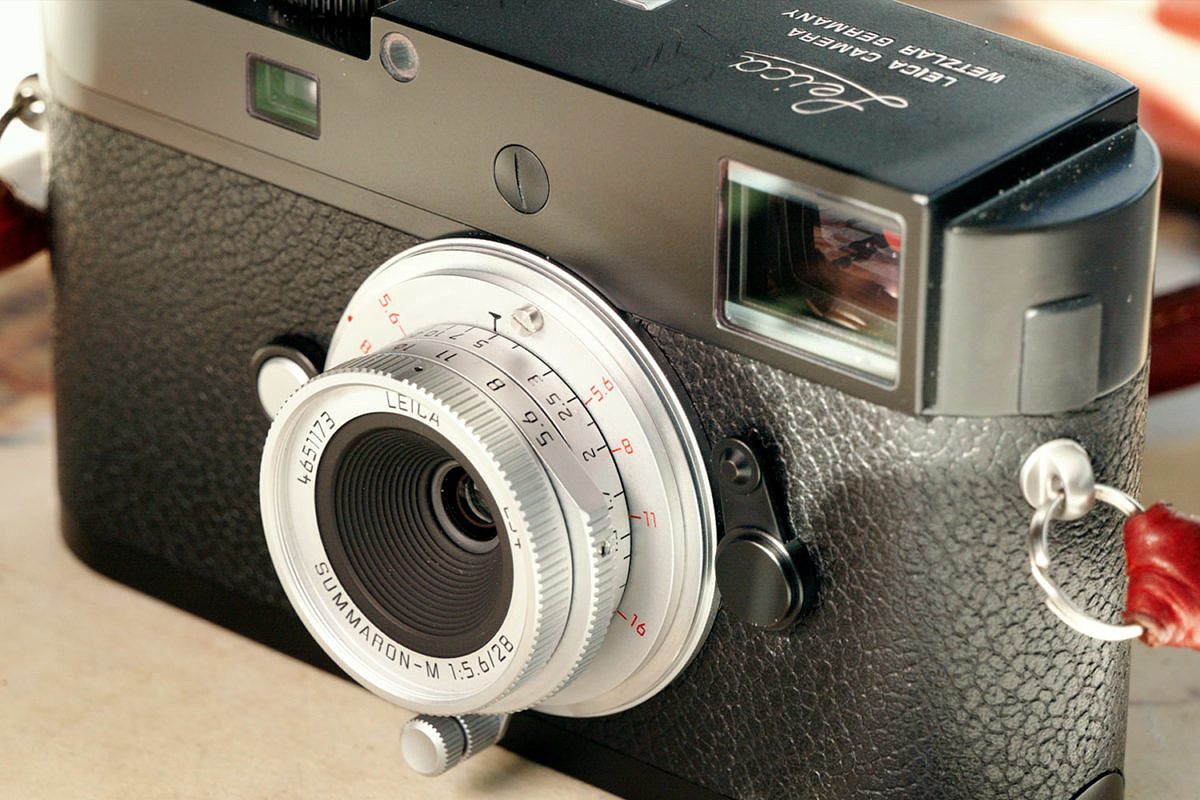Ever since Leica announced that they were reissuing the 28mm Summaron-M, I could’t wait to get my hands on one. I love classic Leica glass. The feel of the images. The vintage styling on the front of my M. The connection with history and legend. There’s just something about rediscovering these older lenses on modern cameras.
The 28mm Summaron features the same optical design of the original, but with updated mechanics, modern-day lens coatings and a 6-bit coded M bayonet mount. Yet, it still looks like something from a bygone era. Awesome.
Protruding less than 2cm, a mere 3/4 inch, from the front of the camera, this is now officially the smallest M lens in the lineup. It’s tiny, but focusing is easy enough with the ridged cylindrical focus knob. In the hand, the brass and glass feel dense, although once mounted, you can barely tell you have a lens on the camera.
I’m a die-hard 35 guy. A 35 Lux or Cron lives on my M. But since the Q came out, I’ve found myself shooting more and more with 28. So, I grabbed the 28mm Summaron and headed to Little Havana for a day of shooting. A lens like this doesn’t warrant scientific testing or pixel peeping. After all, it was originally designed in the mid 1950s. It isn’t going to match up to lenses like the 28mm Summilux-M ASPH, but that’s not why you get a lens like this. On the other hand, the Summaron isn’t just for decoration either. The lens actually is a solid performer, worthy of the Leica name.
So, rather than a strictly defined “test”, I was more interested in the resulting look of the images and how it felt to use for my normal street shooting. On both fronts, I wasn’t disappointed.
Check out the video below for the full scoop and tons of sample images. As always, for best quality be sure to maximize the video and select 4K for viewing resolution.
Be sure to subscribe to our Red Dot Forum YouTube channel for more videos like this.



Video and lens both look lovely! Pity my Internet connection doesn’t work great with 4K video.
Was the video shot with the SL and the same lens?
Thanks! The video was all recorded with the SL. Most of the footage was shot with the 35mm Summilux-TL, the beginning tracking shots were with the 23mm Summicron-TL, and the close-up beauty shots were with the 24-90 SL.
I would love it if you did an article showing your video shooting rig with the external recorder, and presumably the LockCircle cage.
Do you know if Leica is working on implementing the ACES workflow (http://www.oscars.org/science-technology/sci-tech-projects/aces)? That would make it a lot simpler to integrate the SL into larger projects. I see you used an Arri Alexa preset in Premiere (which looks very good, BTW), but the best option would be a dedicated SL ACES IDT.
Bernard,
Yes, this is planned for the future for sure. There is a lot of uncertainty surrounding best practices for video. So many variables.
I will certainly inquire about the ACES workflow, and work to educate myself more on this evolving standard.
Thanks for the feedback.
So David, who was the video shooter? Nice work.
Jack,
Thanks! I shot and edited the video.
Sign me up for your first video webinar or at least send out an alert for a blog post on how to put this together. Point’n and shoot’n and capture on the SD card seems to work OK, but getting good audio in a crowded setting is important, and I see that my gear (Beachtek mixer for line input and powered mikes) which ends up with a standard 3.5 mm plug doesn’t find a socket on the camera body. Is it hopeless to shoot SL video without the extension grip/battery pack?
And I see you are using Premiere, but half the world uses Final Cut X, so which steps can be done both ways?
thanks,
scott
Scott,
There is an audio adapter for the SL to accept 3.5mm miniphone input and also provides a 3.5mm headphone jack for monitoring.
For capturing video, I use a Video Devices PIX-E5H 5″ recording monitor which takes the clean feed off the sensor over HDMI. This allows me to record at 10-bit 422 rather than 8-bit 420 to the SD card. There are other advantages besides the improvement in image quality, but this is a big one. The PIX-E uses the Apple ProRes 422 codec so Final Cut X workflow would be great. I just prefer the Adobe CC ecosystem and work on both Mac and PC, so cross-platform compatibility is important for me.
For audio, I use the Sennheiser AVX wireless mic system. Handles loud environments with ease. The system is about as close to plug-and-play as you can get. For audio recording, I use the PIX-LR audio interface adapter for the PIX-E5. It attaches on the bottom and allows the use of two XLR inputs. The audio sounds amazing, thanks to the implementation of the legendary Audio Devices analog pre-amps and analog limiters.
I’m hoping to publish and article, a video guide or both on best practices for SL video shooting and post-production workflow.
Loved the lenses. The video is extremely well done. Luis you sounded like narrator on a NG special, great.
Thanks or the pointers and subsequent discussion to Sound Devices and Video Devices gear to work in 10 bit Apple ProRes 4:2:2. Does that eliminate the need to shoot in L-Log profile? If you do use L-Log, how do you return it to an atrractive natural look? LUTs or color correction? I’ve gotten color correction working for some L-Log files in FinalCutProX, but am not confident that this is optimal or that it won’t be different in each setting. If you use a LUT, where do you find them and where do they run?
scott
Scott
This video was shot in L-Log, but all of my Photokina reporting was done without shooting in Log. Log gives you more ability to adjust your look later and gives more flexibility in the files.
I apply a LUT in Premiere Pro CC in the Lumetri Color controls. For past videos, I’ve created my own 3D LUT in Davinci Resolve by using a Datacolor SpyderChecker. For this video of Luis in Little Havana, I decided to try something else, so instead used a stock ARRI Alexa LUT that comes pre-loaded into Premiere. The result was a nice “Miami” look. The only downside was losing some of my highlight detail, but the overall look is really nice. Much of color grading is subjective.
Whether shooting in Log and applying a LUT or recording straight with no Log, I still color correct (grade) all my clips so that they have a color continuity through the whole project. I do this through the use of adjustment layers in Premiere Pro, again with Lumetri color controls.
I’ve never used Final Cut, so can’t speak to how this would work under that workflow.
Thanks. I see that even when you do use L-Log plus a LUT, you still find yourself making final color corrections by the clip or by the project. No free lunch. Others (nofilmschool.com, for example, gives examples in FCXP) also say that the LUT is just a starting point. Anyway, I’ve worked through some examples where L-Log in 8 bit 4K, recorded internally on my SL and then corrected manually, is more alive than just shooting 8 bit internal 4K straight from the camera. So I’ll keep exploring in this direction.
There are a few SL video explorers on the Leica User Forum that have come to a practice like yours, but with Final Cut X. Consensus there is to use the Arri Log-C LUT that is provided, but be careful to underexpose by 1-2 stops so that highlights don’t get lost when re-expanding. And everybody then does some hand-tweaking.
Awesome Luis,
Out of all the field test, I thought you truly captured Lil Havana from your heart! Beautiful 28mm Summaron, I love the compact tiny non-intrusive lens. The way you were right in the faces of your subjects and you seem to go unnoticed. Fantastic coverage and video.